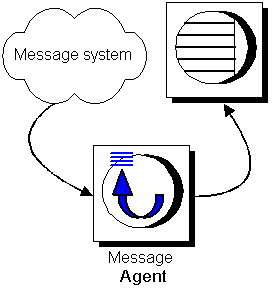







SQL Remote User's Guide
Using SQL Remote with Replication Server
Architecture for Replication Server/SQL Remote installations
The SQL Remote Open Server acts as a replicate database in the Replication Server setup, and so replication definitions and subscriptions are required in the Adaptive Server Enterprise database on all tables participating in SQL Remote replication and on several of the SQL Remote system tables.
All operations are replicated to the SQL Remote Open Server, which stores them in the stable queue. The stable queue does not have copies of the tables being replicated. It parses the inserts, updates, and deletes to build transactions. All transactions are stored in an image column of a single table. These transactions are used by the Message Agent to build SQL Remote messages.

The Message Agent always applies incoming SQL Remote messages directly to Adaptive Server Enterprise. It does not send operations to Replication Server. Incoming messages are applied directly to the consolidated database regardless of how the stable queue is populated. Conflict resolution is also performed in the same way.

SQL Remote allows two-way replication between the consolidated database and remote databases. Replication Server is performing one-way replication from the consolidated database to the SQL Remote Open Server. From Replication Server's perspective, transactions that originate in remote SQL Remote databases appear as transactions originating in the consolidated SQL Remote database.
The SQL Remote Open Server requires information from the SQL Remote system tables concerning publications and subscriptions. The Open Server uses a connection to the Adaptive Server Enterprise database holding that information to retrieve it when it starts.
If the SQL Remote system tables are updated while the Open Server is running, the SQL Remote Open Server needs to receive this information at the correct time. For this reason, some of the SQL Remote system tables need to be marked for replication. This is described in Setting up SQL Remote Open Server.
The SQL Remote Open Server is the following executable:
On Windows operating systems, the SQL Remote Open Server is ssqueue.exe.
On UNIX operating systems, the SQL Remote Open Server is ssqueue.



